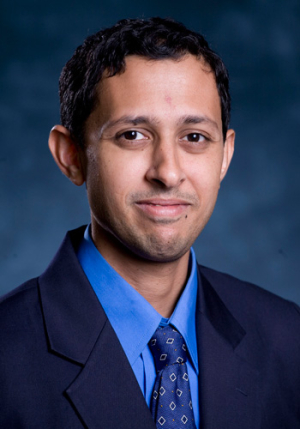A UH Cullen College of Engineering professor has received a grant to develop a new method of testing potential vaccines, and will use this approach to fight a virus identified as an emerging bioterrorism threat.
Navin Varadarajan, assistant professor of chemical and biomolecular engineering, won a two-year, $361,000 grant administered by the Western Regional Center of Excellence for Biodefense and Emerging Infectious Diseases Research and funded by the National Institutes of Health to test potential vaccines for the chikungunya virus. While rarely fatal, chikungunya causes arthritic symptoms so severe that some victims cannot even walk. These effects can last for up to a year.
Spread by mosquito bites, more than 2 million people have contracted chikungunya in the last five years, with most infections occurring in Southeast Asia. Due to global travel, infectious disease experts consider its spread to the United States likely. What’s more, the lack of a vaccine combined with chikungunya’s debilitating symptoms have led federal health and security officials to pinpoint it as a possible bioterrorism agent.
Not surprisingly, then, groups around the world are working to develop a vaccine for the virus, including a team from the University of Texas Medical Branch at Galveston and Tulane University. This is the group with which Varadarajan is partnering.
“What we are looking to study and characterize is vaccine-induced immunity,” said Varadarajan. “If I have a tube of blood from a vaccinated subject, how do we determine the effectiveness of the vaccine?”
Like many vaccines, the ones being developed by the UTMB/Tulane group attack chikungunya in several ways. Varadarajan is testing the ability of potential vaccines to spur the immune system to attack human cells that essentially have been taken over by the virus, becoming reservoirs for it to multiply.
When this occurs, the immune system produces CD8 T-cells that kill the co-opted cells. All CD8 T-cells don’t fight all viruses, though. Instead, each CD8 T-cell is programmed to fight one particular disease. Ideally, the vaccines being tested will spur the immune system to produce CD8 T-cells that recognize only chikungunya-infected human cells.
Using standard research techniques, isolating and studying CD8 T-cells is extremely challenging. These cells are only 10 to 20 microns across, less then a quarter the width of a human hair. Blood samples from subjects injected with the vaccine, however, are usually placed on plates that have wells that measure roughly six millimeters in diameter. Such a huge size disparity makes it extremely difficult to identify CD8 T-cells that are specific to a certain virus, and nearly impossible to isolate and study them for an extended period.
Varadarajan, then, is developing a specialized polymer slide dubbed the microwell array. Roughly the size of a standard slide, it consists of approximately 85,000 individual chambers, each 50 microns by 50 microns — just the right size to isolate and study individual cells.
“If we shrink the container small enough so that its dimensions are similar to those of a single cell, we can achieve almost single-cell resolution. So within the same footprint, we can look at lots of cells,” said Varadarajan.
After a blood sample is placed on the microwell not all the cells isolated in its chambers will be CD8 T-cells programmed to fight chikungunya, of course. To see which ones do, Varadarajan will then introduce into the chambers cells that have been covered with pieces of the chikungunya virus, spurring the cD8 T-cells that attack chikungunya into action.
Varadarajan will then use a microscope to take images of each chamber and a computer program will analyze these images and identify the CD8 T-cells that are fighting chikungunya. He will next remove those cells from their chambers and clone them by the million, allowing him to study every aspect of the CD8 T-cells that attack chikungunya.
With this information, Varadarajan will be able to evaluate the effectiveness of potential vaccines for chikungunya and provide guidance on vaccine development to his partners.
“Finding a chikungunya vaccine is a priority given the virus’ potential to spread quickly and its possible use in bioterrorism,” said Varadarajan. “With this research, we can help the vaccine developers identify which potential vaccines are most effective and, hopefully, find a suitable one as quickly as possible.”
